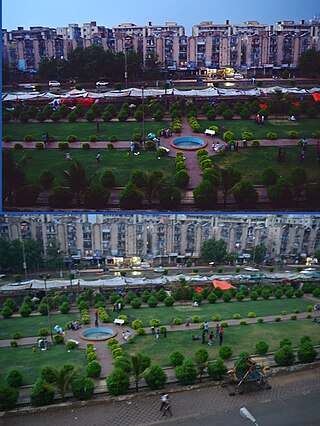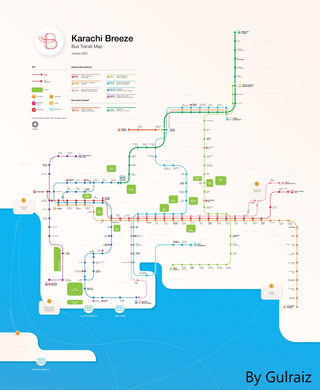Related Research Articles

Karachi is the largest city in Pakistan and 12th largest in the world, with a population of over 20 million. It is situated at the southern tip of the country along the Arabian Sea coast. It is the former capital of Pakistan and capital of the province of Sindh. Ranked as a beta-global city, it is Pakistan's premier industrial and financial centre, with an estimated GDP of over $200 billion (PPP) as of 2021. Karachi paid $9 billion as tax during fiscal year July 2021 to May 2022 according to FBR report. Karachi is Pakistan's most cosmopolitan city, linguistically, ethnically, and religiously diverse, as well as one of Pakistan's most socially liberal cities. Karachi serves as a transport hub, and contains Pakistan's two largest seaports, the Port of Karachi and Port Qasim, as well as Pakistan's busiest airport, Jinnah International Airport. Karachi is also a media center, home to news channels, film and fashion industry of Pakistan. Most of Pakistan's multinational companies and banks have their headquarters in Karachi. Karachi is also a tourism hub due to its scenic beaches, historic buildings and shopping malls.

Landhi is a residential neighbourhood and an industrial municipality in the eastern part of Karachi, Pakistan. It is bordered by the Faisal Cantonment and Shah Faisal Colony to the north across the Malir River, Bin Qasim Port to the south and east, and Korangi to the west.

Landhi Town was a Karachi borough in the eastern part of the city that was named after the locality of Landhi. Landhi Town was formed in 2001 as part of The Local Government Ordinance 2001, and was subdivided into 9 union councils. The town system was disbanded in 2011, and Korangi Town was re-organized as part of Karachi East District, before Korangi District was formed.

Malir Town lies in the northern part of the city that was named after the Malir River.

Gulistan-e-Jauhar or Gulistan-e-Johar is a prominent neighborhood in the Karachi East district of Karachi, Pakistan. It is famous for its vibrant culture, Gulistan-e-Jauhar is named after Maulana Mohammad Ali Jauhar, a prominent figure in the Pakistan Movement. The neighborhood is distinguished by a myriad of apartment blocks, contributing to its dynamic urban landscape.

Karachi Circular Railway is a partially active regional public transit system in Karachi, Sindh, Pakistan, which serves the Karachi metropolitan area. KCR was fully operational between 1964 and 1994, until it was abruptly shutdown in 1999. Since 2001, several restart attempts were sought and in November 2020, the KCR partially revived operations on the orders of Supreme Court of Pakistan.
The Karachi Cantonment is a cantonment town of the city of Karachi, in Sindh, Pakistan.

The Clifton Cantonment is a cantonment town within the city of Karachi, Sindh, Pakistan.

The Faisal Cantonment is a cantonment town of the city of Karachi, in Sindh, Pakistan. It serves as an Airforce base and residential establishment.

The Malir Cantonment is a cantonment town of the city of Karachi, in Sindh, Pakistan. It serves as a military base and residential establishment.

London's water supply infrastructure has developed over the centuries in line with the expansion of London. For much of London's history, private companies supplied fresh water to various parts of London from wells, the River Thames and the River Lea. Further demand prompted new conduits and sources, particularly when the Agricultural and Industrial Revolution caused a boom in London's population and housing.

Neher water system provided clean water for the people of Aurangabad and its suburbs. It was created by Malik Ambar who founded the town under the name Khadki and was later expanded by Aurangzeb to facilitate the military activity that became prevalent under Mughal rule during the 17th century.

Malir District is an administrative district of Karachi Division in Sindh, Pakistan.

Karachi Breeze is a 112.9 km (70.2 mi) is a network of bus rapid transit lines under construction in Karachi, Pakistan. Construction began in 2013, two lines are operational and two lines are under construction as of September 2022, with 2 more planned. The projected ridership of the first line is estimated at 350,000 passengers per day, with a total of 109 km of dedicated bus routes. Upon completion, it will become the largest BRT network in Pakistan, and will connect to the Karachi Circular Railway.
K-IV water project, abbreviated as K-IV, is a pending water supply project from last 19 years being jointly developed by the provincial and federal governments in Karachi, Pakistan, to augment the city's daily water supply. The estimated cost was approximately Rs.25.5 billion PKR, which now increased to 150 billion PKR, while the project is designed to provide 650 million gallons of water daily to Karachi in three phases. The new water supply will be extracted from Keenjhar Lake through three water canals. The project was slated for completion in mid-2019. K-IV water project is part of Karachi Bulk Water Supply Project.

Karachi–Peshawar Railway Line is one of four main railway lines in Pakistan, operated and maintained by Pakistan Railways. The line begins from Karachi City station or Kiamari station and ends at Peshawar Cantonment Station. The total length of this railway line is 1,687 kilometers (1,048 mi). There are 184 railway stations from Kiamari to Peshawar Cantonment on this line. The line serves as the main passenger and freight line of the country. 75% of the country's cargo and passenger traffic uses the line. The line is currently undergoing a six-year Rs. 1286.68 billion (US$4.5 billion) upgrade and renovation as part of the China Pakistan Economic Corridor, with average rail speeds expected be doubled to 160 kilometers per hour upon completion.

Karachi is located on the coastline of Sindh province in southern Pakistan, along a natural harbour on the Arabian Sea. The city has a very diverse population with very affluent areas such as Clifton and large areas of people living in middle class environments. Karachi is ranked as a Beta world city in the GaWC index, and is widely recognized as the prime financial and transport hub of Pakistan.
The Mourne Conduit was a water main which ran 42 kilometres (26 mi) from the Silent Valley Reservoir to Carryduff, near Belfast and was built between 1893 and 1901 for the Belfast City and District Water Commissioners. This was supplemented by additional pipelines twice in the 20th Century. This system supplied water to Greater Belfast and North Down for more than 100 years. It is labelled as the Mourne Aqueduct in Ordnance Survey maps from the early 20th century.
Malir Expressway is a 39 km under construction expressway starting from KPT Interchange, passes through Qayyumabad and conclude at the Karachi-Hyderabad Motorway near Kathore, along the Malir River in Karachi, Pakistan. One of the major infrastructure developments in Karachi city which is unviable for the provincial government and detrimental to the city's climate. It was announced that half of it will be opened on 14th August 2023 which has been indefinitely delayed since the Asian Development Bank has withdrawn the funding for the construction ADB decides against financing Karachi’s Malir Expressway; as of right now there is illegal excavation happening on the Malir River bed and the fields of Malir; it is unlikely that Expressway will be completed given the litigation and damage to the only surviving river in Karachi.
References
- ↑ Hasan, Shazia (August 4, 2013). "The 12 remaining Dumlottee wells". Dawn . Archived from the original on October 10, 2022. Retrieved May 18, 2023.
- ↑ "'ڈملوٹی اسکیم' برطانوی دور کا پہلا فراہمی آب کا نظام". Daily Jang . Archived from the original on 2023-01-19. Retrieved 2023-05-18.
- 1 2 3 4 5 6 7 8 9 10 11 12 "Dumlottee Conduit: A neglected historical asset". The Express Tribune . October 2, 2019. Archived from the original on August 28, 2022. Retrieved May 18, 2023.